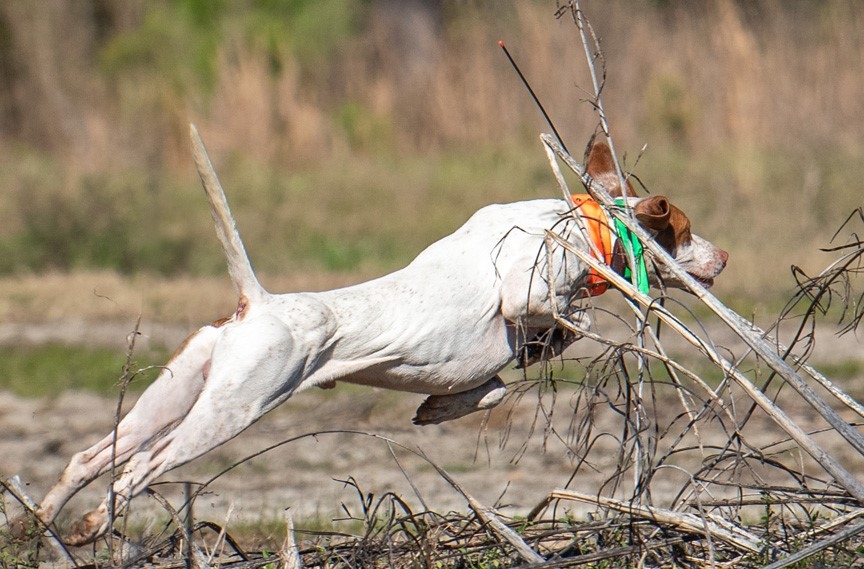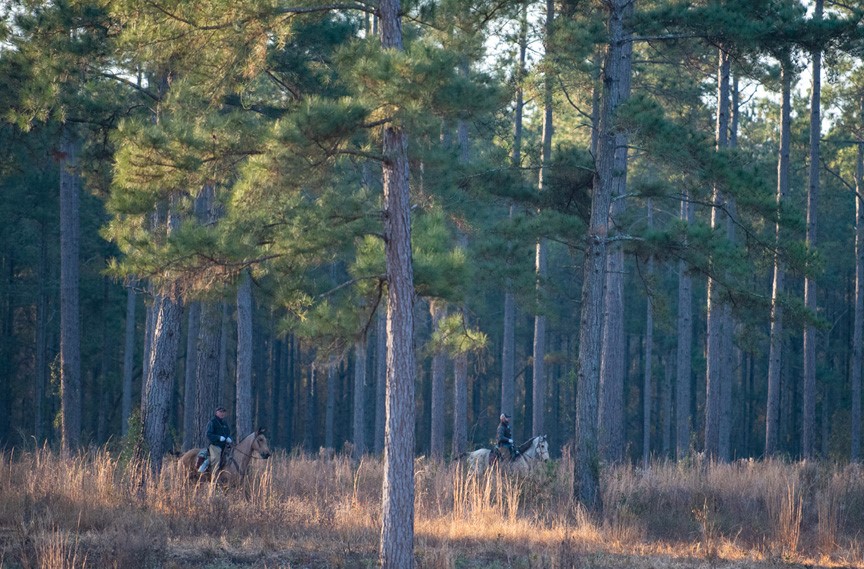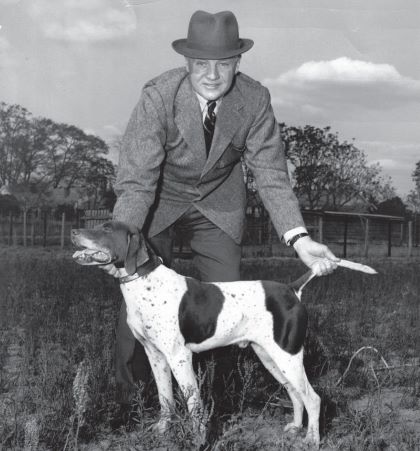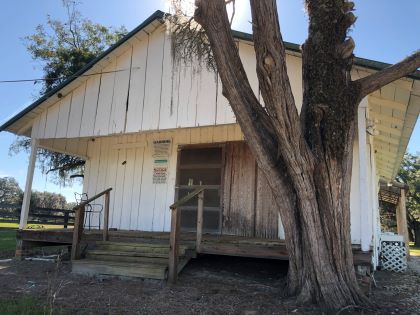Behind the Scenes of the Prestigious Continental Field Trails

With a total of 38 years between them working on Livingston Place, Randy Floyd and Clay Sisson have taken charge of preparing one of the few remaining field trials in America that still boasts wild quail. With the 84th consecutive Continental Field Trails slated for the third Monday in January at Livingston Place in Greenville, Florida, Randy and Clay are hard at work sweating the details on this prestigious competition.
Of the 9,150 acres that encompass Livingston Place, some 5,000 are reserved for hunting wild quail and the Continental. But as the men prepare the land and facilities for the field trials, it’s not all fun and games. There’s also a little thing called money.
 From left: Clay Sisson and Randy Forbes with dog trainer Jason Williams on Livingston Place.
From left: Clay Sisson and Randy Forbes with dog trainer Jason Williams on Livingston Place.In particular, Livingston Place is owned by Tall Timbers Research Station in nearby Tallahassee, Florida. Devotees of quail hunting know Tall Timbers as the touchstone of habitat fire ecology and the advocacy to protect the right to use prescribed fire for land management. The non-profit is also recognized as one of America’s leading land trusts. Under the management of Tall Timbers, Livingston Place is an ideal environment for research and educational programs for landowners, college students and scientists.
Located in the Red Hills region of bobwhite quail country that roughly encompasses Tallahassee north to Thomasville, Georgia, Tall Timbers uses this sprawling backyard to test and implement its management practices on local multi-million-dollar ecosystems comprised mostly of private quail plantations. Owners of these properties not only support Tall Timbers, but rely on the research to keep their quail habitats healthy and productive.
 Two handlers on the morning course of the 2021 Continental Field Trials (photo: Chris Mathan).
Two handlers on the morning course of the 2021 Continental Field Trials (photo: Chris Mathan).“Because Tall Timbers is a private non-profit, Livingston Place has been tasked with paying for itself,” says Clay, who is a director of both Livingston Place and the Albany Quail Project at Tall Timbers. An ongoing challenge has been overcoming the decline in the number of people involved in field trials. “Ten years ago, we had about 25 all-age dog handlers,” he said. “Last year we had about 10 with about 100 dogs. These are professional and amateur handlers who travel the circuit plus some local handlers.”
You don’t have to be Einstein to run the math: fewer paying participants and rising costs mean that Clay and Randy have to sharpen their pencils when it comes to prepping Livingston Place for the Continental.
Field trailers in-the-know and Tall Timbers supporters recognize the name Livingston Place. But many hard-liners cling to the old appellation of Dixie Plantation, ignoring the name change put in place October 2020.
As one of the local old-timers told me, “It will always be Dixie Plantation to me.”
Tall Timbers was renamed Livingston Place to honor Geraldine Livingston and her family’s legacy in the Red Hills, as well as the Geraldine C.M. Livingston Foundation’s conservation efforts and donation to Tall Timbers.
 The 14,000-plus-square-foot Neo-Classical Revival style house built between 1938 and 1940 that served as the Livingston family’s residence on Livingston Place.
The 14,000-plus-square-foot Neo-Classical Revival style house built between 1938 and 1940 that served as the Livingston family’s residence on Livingston Place.In 2013, the trustees of the Livingston Foundation proposed to Tall Timbers the donation of Dixie Plantation and their foundation assets.
The transaction was approved by the Livingston family, Geraldine C. M. Livingston Foundation Trustees and the Suwanee River Water Management District, who holds the conservation easement on the property, as well as the Tall Timbers Board of Trustees. In line with Geraldine’s wishes to preserve Dixie Plantation in perpetuity, all but 225 of the plantation’s 9,100 Florida acres were placed in a conservation easement in 2009 to further safeguard Dixie’s integrity – an action that guaranteed the protection and conservation of her varied wildlife and ecology going forward. At the time it was the largest gift ever to Tall Timbers since its founder, Henry Beadel, donated his 2,400-acre property and endowed the institution in 1958.
 Gerald M. Livingston
Gerald M. LivingstonLivingston Place started in the early nineteenth century. It was first settled as a cotton plantation in 1819-20. In 1919, it was purchased by a group of Macon, Georgia businessmen and renamed Georgia-Florida Farm still farming cotton. In 1926, a group from New York City prepared to take over the land with small farmers from Iowa, but the plan proved unfeasible. Come the1920s, one of the group, Gerald M. Livingston, bought out the others, and renamed the 7,500-acre property Dixie Plantation. The acreage was expanded and remained in the Livingston Family until 2013.
Meanwhile, the Continental Field Trials continue at Livingston Place, where the event has been held since 1937. It lasts between 10 and 15 days, running two dogs at a time per hour over a course that’s approximately 30 miles across and comprises six different courses.
“Preparing the courses is a year-long process,” says Clay, as we tour the property in a well-worn pick-up truck.
 A dog breaks away on the afternoon course of the 2021 Continental Field Trials at Livingston Place (photo: Chris Mathan).
A dog breaks away on the afternoon course of the 2021 Continental Field Trials at Livingston Place (photo: Chris Mathan).Leading up to the Continental, the Livingston Place crew works on removing undesirable upland hardwood, checkerboarding hunting paths into the land, prescribed burns, roller chopping, spraying herbicides, spreading supplemental feed for quail and maintaining the roads and trails. With the clock counting down to the field trail, it takes four men about eight to ten weeks just to do the checkerboarding, also known as “blocking.”
 A tractor driver pulling a roller chopper during the blocking process in preparation of the 2022 Continental Field Trials at Livingston Place.
A tractor driver pulling a roller chopper during the blocking process in preparation of the 2022 Continental Field Trials at Livingston Place.Then there’s the chore of balancing the ledger. In addition to holding the title of manager at Livingston Place, Randy has been president of the Continental Field Trial Club for the past eight years. The club, a 501(c)(3) non-profit, is responsible for paying $50,000 to Livingston Place for the two-week use of the field trial. Randy explained that, although the field trails cover some part of the payment, the club also raises money through fundraising and sponsorships.
 The original commissary on Livingston Place where meals are often served during the Continental Field Trials.
The original commissary on Livingston Place where meals are often served during the Continental Field Trials.If the price seems excessive, bear in mind that as a financially self-sufficient operation, Livingston Place must generate nearly $1,000,000 per year of income. This requires growing timber, a farm lease, deer and turkey hunting leases, the field trial and leased quail hunting.
Livingston Place just happens to offer highly sought wild quail hunts that cost $10,000 per day for four hunters, plus the cost of dogs if needed and horses. Only one group is permitted to hunt at a time, generally for one to two days. Hunting is limited to three days per week across a landscape that prides itself on producing 1.5 to 2 quail per acre. There are 30 days of quail hunting per year on Livingston Place, with lodging on the property.
According to Clay, “All of the hunters are return customers, and we have a long waiting list.”
Irwin Greenstein is the publisher of Shotgun Life. You can reach him at contact@shotgunlife.com.
Useful resources:
The Tall Timbers Research Station and Livingston Place web site

Irwin Greenstein is Publisher of Shotgun Life. Please send your comments to letters@shotgunlife.com.


Comments